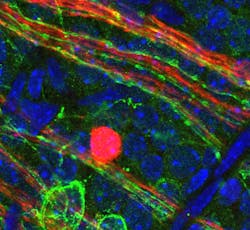Ophthalmology/Oncology: New efforts indicate expanded application of photobiomodulation
Recent announcements demonstrate promise for wider application and acceptance of photobiomodulation (PBM), or low-level-light therapy (LLLT), for disease prevention and treatment and pain relief.
A research group led by Cincinnati Children’s Hospital Medical Center (Cincinnati, OH) has developed a new technique that may enable light-based treatment for eye diseases including severe nearsightedness (an increasingly common condition in adults) and others. “Our study indicates opsin 5-dopamine pathway is probably part of a light-dependent disease process for conditions like myopia,” says the center’s Visual Systems Group director Richard A. Lang. “It raises the interesting possibility that we might be able to use light exposure to treat conditions like retinopathy of prematurity after a premature infant is born, or in people with myopia.” Lang is senior author on a paper describing the work.1
The team, including researchers at the University of Washington Medical School (Seattle, WA), the Institute of Molecular Genetics and the Academy of Sciences of the Czech Republic, the Emory University School of Medicine (Atlanta, GA), and the University of Cincinnati College of Medicine, studied eye development, including influences of the opsin 5-dopamine pathway, in postnatal mice. The opsin 5-dopamine molecular process helps ensure blood-vessel development that eventually enables eyesight. In premature babies, the process is prone to misdevelopment. Lang explains that opsin 5, a protein expressed in retinal photoreceptor cells, is highly conserved in species evolution, meaning that the mouse-model findings are promising for humans.
The researchers showed that in postnatal mice, the opsin 5 protein controls retinal light responses for proper eye development (see figure). The opsin 5 works together with dopamine, which promotes blood vessel regression, to regulate balanced vascular development in the eye. Study of genetically modified mice illustrated that non-expression of opsin 5 resulted in increased levels of dopamine in the eyes’ clear, gel-like vitreous humor. This in turn caused blood vessels in the eyes to quickly regress, hindering normal development.
To test the impact of photostimulation, the team used 380 nm violet light to activate opsin 5-based signaling. This produced intraocular molecular changes, including a decrease in dopamine, that enabled restoration of timing cues needed for properly balanced vascular development.
Healing and pain relief
Meanwhile, a $1.5 million grant is allowing researchers to investigate application of light for prevention and treatment of oral mucositis, which are painful ulcers that result from chemotherapy and radiation therapy in cancer patients. The funding is also enabling development of instrumentation to deliver the low-dose light therapy.
The grant, funded by the National Institutes of Dental and Craniofacial Research’s (NIDCR) Small Business Innovation Research (SBIR) program, was awarded to MuReva Phototherapy (Cleveland, OH). A spinoff of lighting solutions manufacturer Lumitex, MuReva will further develop the technology. Lumitex launched MuReva after a 2017 pilot study showed that near-infrared intraoral LED phototherapy limited cell death in the oral mucosa of cancer patients. The company designed a mouthpiece to deliver an optical power of 4 to 6 J/cm2. “Current approaches for delivering a photobiomodulation-utilizing laser for oral mucositis require a physician to spend 30 minutes per patient, per day, and are too impractical an approach for mass adoption,” says Vedang Kothari, president and CEO of MuReva Phototherapy.
Researchers at the University at Buffalo (UB; Buffalo, NY) will use about a third of the grant funding to test the technology. Praveen Arany, assistant professor in the UB School of Dental Medicine, is leading the testing, which seeks to uncover the correct dosage needed to relieve pain and stimulate tissue repair. Arany explains that the current opioid problem has impacted patients needing pain relief from cancer treatment, and that the light therapy can effectively serve as a replacement for prescription opioids.
Congressional pitch
In a presentation to the U.S. Congress in late 2018, CEO and founder of THOR Photomedicine (Chesham, England) James Carroll reported that 500 published randomized placebo control clinical trials have investigated PBM, and yet most medical professionals have not heard of it. Like Arany, Carroll presented PBM as a problem-solving tool for the epidemic that in 2017 killed 19,000 people prescribed opioids for pain. “Photobiomodulation therapy can help reduce the prescribing of opioid medication for pain relief and we wish to draw attention to the Congress and healthcare policymakers, NIH and CMS, about this potentially valuable tool,” said Carroll. He explained PBM as the noninvasive application of a specific wavelength of light at “the right intensity (from below 5 to 500 mW) for the right amount of time,” which accelerates tissue repair, reduces inflammation and edema, and induces an analgesic effect. He noted that published clinical evidence highlights these effects for musculoskeletal pain (sprains and strains and creaky joints), neuropathic pain, non-healing wounds, and the oral mucositis for which opioids are often prescribed. Carroll referenced a longitudinal study that followed 108 cancer patients for 8 years and showed that the group actively treated with for oral mucositis had better long-term, progression-free survival.
Carroll’s presentation was part of the first ever Congressional briefing on PBM. It involved Arany and others representing 17 scientific and medical organizations, and it emphasized lowering of healthcare costs among other themes. The briefing was timely, given the recent passage of the Opioid Crisis Response Act of 2018 (OCRA), which expands programs for opioid prevention, treatment, and recovery. More details are available at www.congresspbm.com.
REFERENCE
1. M-T. T. Nguyen et al., Nat. Cell Biol., 21, 420–429 (2019).

Barbara Gefvert | Editor-in-Chief, BioOptics World (2008-2020)
Barbara G. Gefvert has been a science and technology editor and writer since 1987, and served as editor in chief on multiple publications, including Sensors magazine for nearly a decade.
